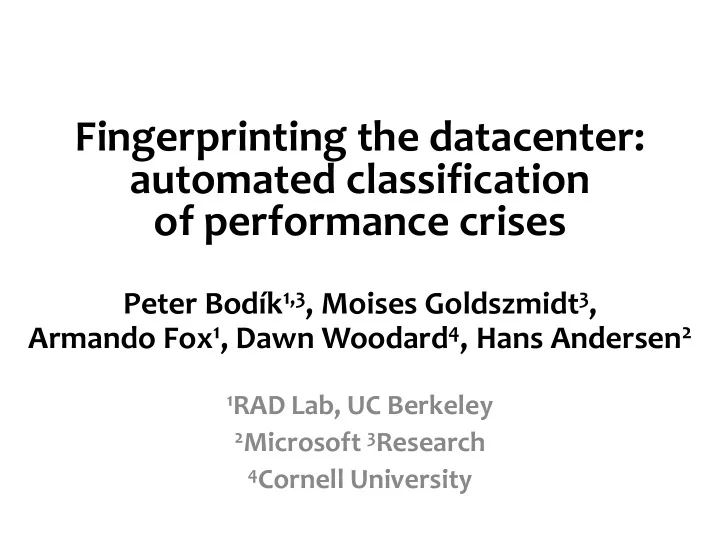

Fingerprinting the datacenter: automated classification of performance crises Peter Bodík 1,3 , Moises Goldszmidt 3 , Armando Fox 1 , Dawn Woodard 4 , Hans Andersen 2 1 RAD Lab, UC Berkeley 2 Microsoft 3 Research 4 Cornell University
Crisis identification is difficult, time consuming and costly Frequent SW/HW failures cause downtime Timeline of a typical crisis OK – detection: automatic, easy 3:00 AM – identification: manual, difficult CRISIS 3:15 AM • takes minutes to hours – resolution: depends on crisis type 4:15 AM – root cause diagnosis, documentation next day OK Web apps are complex and large-scale – app used for evaluation: 400 servers, 100 metrics 2
Insight: performance metrics help identify recurring crises Performance crises recur – incorrect root cause diagnosis – takes time to deploy the fix • other priorities, test new code System state is similar during similar crises – but not easily captured by fixed set of metrics – 3 operator-selected metrics not enough 3
Contribution: crisis identification as it happens, via classification 1. Fingerprint = compact representation of system state – uniquely identifies a crisis – robust to noise – intuitive visualization 2. Using fingerprints to identify crises as they happen – goal: operator receives email about crisis – “Crisis similar to DB config error from 2 weeks ago” 3. Evaluation on data from a real commercial service deployed on hundreds of servers – 80% identification accuracy 4
Outline • Definition of performance crises • Crisis fingerprints • Evaluation results • Related work • Conclusion 5
Definition and examples of performance crises Performance crisis = violation of service-level objective (SLO) – based on business objectives – captures performance of whole cluster – example: >90% servers have latency < 100 ms during 15-minute epoch Crises we analyzed – app config, DB config, request routing errors – overloaded front-end, overloaded back-end 6
Fingerprints capture state of performance metrics during crisis Metrics as arbitrary time series – OS, resource utilization, workload, latency, app, … 1: CPU utilization 1: select server 1 relevant metrics 2: workload … … 100: latency 2: summarize using quantiles 1: CPU utilization server 2 2: workload 3: map into … … hot/normal/cold 100: latency … 4: average over time 1: CPU utilization server 1000 2: workload crisis … … fingerprint 100: latency 7 OK CRISIS OK
Step 1: Using feature selection to pick relevant metrics • all 100 metrics what would low identification not work • 3 operator-selected metrics accuracy Logistic regression with L1 constraints – fit accurate linear more with only few metrics – selected metrics that operators didn’t consider 1: CPU utilization model input (all metrics) 2: workload … … 100: latency model output OK CRISIS OK (binary) 8 time
Step 2: Summarize selected metrics across servers using 3 quantiles # servers 0% CPU utilization 100% 25 th percentile 50 th percentile, 95 th percentile median • robust to outliers • can efficiently compute even for datacenter- sized clusters • mean, variance what would not work • only median 9
Step 3: Map metric quantiles into hot/normal/cold overloaded back-end Based on historic values time overloaded back-end Epoch fingerprints – differentiate among crises – compact DB config error – intuitive • raw metric values what would app config error • time series model not work 10 10
Step 4: Averaging over time Different crises have different durations • all epoch fingerprints what would • 1 epoch fingerprint not work Crisis fingerprint – average epoch fingerprints over time – compare by computing Euclidean distance epoch fingerprints crisis fingerprint is a vector
Crisis identification in operational setting OK Crisis detected automatically via SLO violation During first hour of crisis ? ? A A A CRISIS – update fingerprint of current crisis epochs – if found similar crisis P, emit label P else emit ? – “previously - unseen crisis” When crisis is over – automatically update relevant metrics, fingerprints OK – ideally, operators enter supplied label into crisis DB 12
Outline • Definition of performance crises • Crisis fingerprints • Evaluation results • Related work • Conclusion 13
System under study 24 x 7 enterprise-class user-facing application at Microsoft – 400 machines – 100 metrics per machine, 15-minute epochs – operators: “Correct label useful during first hour” Definition of a crisis – operators supplied 3 latency metrics and thresholds – 10% servers have latency > threshold during 1 epoch 19 operator-labeled crises of 10 types – 9 of type A, 2 of type B, 1 each of 8 more types – 4-month period 14
Evaluation results Identification stability = stick to first label – unstable: ??A??, AABBB – stable: ?????, AAAAA, ??AAA Previously-seen crises: – identification accuracy: 77% – identified when detected or one epoch later For 77% of crises, average time to ID 10 minutes – could potentially save up to 50 minutes – more with shorter epochs Accuracy for previously-unseen crises: 82% 15
More results in the paper Comparison to other approaches – using all metrics – 3 operator-specified metrics – failure signatures [SOSP ‘05] Updating fingerprints Sensitivity analysis Online-clustering approach – model evolution of fingerprint during crisis – doesn’t assume 100% correct labeling of crises 16
Closest related work • Capturing, indexing, clustering, and retrieving system history, SOSP ’05 – authors: Cohen, Zhang, Goldszmidt, Symons, Kelly, Fox • Failure signatures – signature for individual servers – build and manage per-crisis classification models – detailed comparison in the paper 17
Conclusion Crisis fingerprint – compact representation of system state – scales to large clusters – intuitive visualization Use of Machine Learning crucial for metric selection Correct identification for 80% crises – on average after 10 minutes – rigorous evaluation on production data Selection of relevant metrics used at Microsoft 18
Thank you! 19
Recommend
More recommend